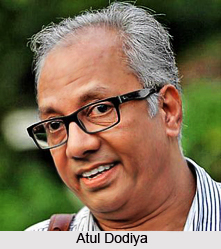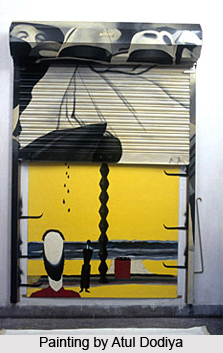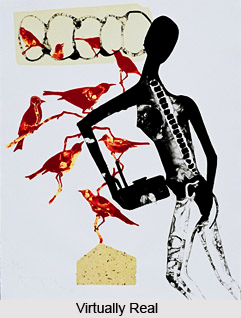 "For a figurative painter like me, the reality is slightly different. I live in Ghatkopar, my figures are Indian in the sense that they would be dark skinned and they portray the life in India that includes the poverty, the concerns and the reality. But I don`t make any political statements."-- Atul Dodiya. He is regarded one of the most sought-after contemporary artists of India. Since his childhood Atul Dodiya was passionate about painting. Dodiya rose to prominence with his extraordinary series on Mahatma Gandhi. Through the series he has attempted to reconstruct images of Gandhi from a forgotten biography of the leader.
"For a figurative painter like me, the reality is slightly different. I live in Ghatkopar, my figures are Indian in the sense that they would be dark skinned and they portray the life in India that includes the poverty, the concerns and the reality. But I don`t make any political statements."-- Atul Dodiya. He is regarded one of the most sought-after contemporary artists of India. Since his childhood Atul Dodiya was passionate about painting. Dodiya rose to prominence with his extraordinary series on Mahatma Gandhi. Through the series he has attempted to reconstruct images of Gandhi from a forgotten biography of the leader.
Atul Dodiya was born in 1959 in Mumbai. He originally belongs to a liberal Kathiawadi family. His family members wanted him to be an architect. But however he managed to enter the Sir J. J. School of Arts and obtained a Bachelor`s Degree in Fine Arts in 1982. After passing out from college he started teaching in the college where he met his wife Anju. She is also a contemporary artist. Between the years 1991 and 1992, he went to Paris to participate in an academic training programme that was awarded to him as a scholarship given by the French Government.
Atul Dodiya has exhibited his works through solo exhibitions like-- 2007 `Saptapadi - scenes from marriage`, Vadhera Art Gallery, New Delhi; 2006 `The Wet Sleeves of My Paper Robe`, Singapore Tyler Print Institute, Singapore, Mumbai and New York; 2005 Cracks in Mondrian, Bose Pacia, New York; 2004 Faculty of Fine arts, Vadodara; 2003 Broken Branches, Bose Pacia, New York; 2002 E.T. and Others, Walsh Gallery, Chicago; 2002 E.T. y los otros, Espacio Uno, Reina Sofia Museum, Madrid; 2002 Lives and works in Bombay, Sakshi Gallery, Mumbai; 2001 Bombay: Labyrinth/Laboratory, The Japan Foundation Asia Center, Tokyo; 2001 The Fine Art Resource, Berlin; 2001 Gallery Chemould, Mumbai; 1999 Vadehra Art Gallery, New Delhi; 1999 Herwitz Gallery, Ahmedabad; 1997 Centre of International Modern Art (CIMA), Kolkata; 1999,97,95,91,89 Gallery Chemould, Mumbai; 1993 Gallery Apunto, Amsterdam.
 Some Group Exhibitions of Atul Dodiya are-- 2005 `I Con: India Contemporary`, collateral event, 51st Venice Biennale; 2005 - `Bhupen Among Friends` Gallery Chemould, Mumbai; 2004-06 `Edge of Desire: Recent Art in India`, Art Gallery of Western Australia, Perth; Asia Society Museum, New York; Tamayo Museum, Mexico City; Museum of Contemporary Art (MARCO) Monterrey, Mexico; Asian Art Museum of San Francisco; Royal Ontario Museum, Toronto; 2004 `Interlude in Sri Lanka`, Guild Art Gallery, Mumbai; 2004 `Androgene`, India Habitat Center, New Delhi; 2004 `The Search`, paintings from National Gallery of Modern Art (NGMA), Mumbai, Omni Society for Fine Arts, Muscat, Sultanate of Oman; 2004 `ZOOM! (Art in Contemporary India)`, Museo Temporario / Culturgest, Lisbon; 2004 `Masala`, Diversity and Democracy in South Asian Art, William Benton Museum of Art, University of Connecticut Storrs; 2004 `Vanitas Vanitatum`, Sakshi Gallery, Mumbai; 2004 `South Asian Masters at Alhamra`, Alhamra Center, Lahore; 2003 `body. city: siting contemporary culture in India`, House of World Cultures, Berlin; 2003 `Under the Skin of Simulation`, Three Contemporary Painters from India, with Shibu Natesan and Surendran Nair, Fine Art Resource, Berlin; 2003 `SubTerrain`, Artworks in the cityfold, Haus der Kulturen der Welt, Berlin; 2003 Portraits of a Decade, 10th anniversary show, CIMA Gallery, Kolkata; 2003 `Crossing Generations: diVERGE`, Forty Years of Gallery Chemould, an Exhibition Spanning Four Generations of Artists, National Gallery of Modern Art, Mumbai; 2003 `Sub Terrain: Artworks in the cityfold` ,House of World Cultures, Berlin; 2003 `The Tree from the Seed`, Contemporary Art from India, Henie Onstad Center, Oslo; 2002 `Secular Practice: Recent Art from India`, Contemporary Art Gallery (CAG) Vancouver; 2002 `Capital and Karma: Recent Positions in Indian Art`, Kunsthalle, Vienna; 2002 `New Indian Art: Home - Street - Shrine - Bazaar- Museum`, Manchester Art Gallery, Manchester; 2001 `The Mega Wave` Yokohama Triennale. Yokohama, Japan; 2001 `Century City : Art and Culture in the Modern Metropolis`, Tate Modern, London; 2001 Moving Ideas: A Contemporary Dialogue with India, OBORO, Montreal; 2000 `Shatabdi - Reflections on a century past`, Centre of International Modern Art (CIMA), Kolkata; 2000 `Embarkations` - The Millennium show, Sakshi Gallery, Mumbai; 2000 `Kala Ghoda - A Meeting Place`, collaborative installation with Architect Rahul Mehrotra, Gallery Chemould, Mumbai; 2000 `Family Resemblance`, Birla Academy of Art and Culture, Mumbai; 1999 `Water color and Contemporary Painting`, Gallery Art Motif, New Delhi; 1999 `The Art of Charity`, organised by Sir Jamsetjee Parsee Benevolent Institution at Sir J.J. School of Applied Art, Mumbai; 1999 CIAF `99 - Contemporary Indian Art Fair, organised by Apparao Galleries, Apollo Apparao Galleries, Mumbai; 1999 Harmony Show - organised by Reliance Industries, Nehru Center, Mumbai; 1999 Singapore Indian Fine Arts Society at CJIMES, Singapore; 1999 `Legatee - Sir J.J. School of Art`, The Fine Art Company, Mumbai; 1999 `Icon of the Millennium`, organised by Lakeeren Gallery at Nehru Centre, Mumbai; 1999 `Watermark` - watercolour show organised by the Fine Art Resource, at Jehangir Art Gallery, Mumbai; 1999 `Two for Two Thousand`, Art Today, New Delhi; 1999 `As You Like It`, organied by Vadehra Art Gallery, Jehangir Art Gallery, Mumbai; 1999 `Kalchakra`, A Benefit event for the Elephanta project organised by INTACH - Mumbai; 1999 `Ideas and Images`,
Some Group Exhibitions of Atul Dodiya are-- 2005 `I Con: India Contemporary`, collateral event, 51st Venice Biennale; 2005 - `Bhupen Among Friends` Gallery Chemould, Mumbai; 2004-06 `Edge of Desire: Recent Art in India`, Art Gallery of Western Australia, Perth; Asia Society Museum, New York; Tamayo Museum, Mexico City; Museum of Contemporary Art (MARCO) Monterrey, Mexico; Asian Art Museum of San Francisco; Royal Ontario Museum, Toronto; 2004 `Interlude in Sri Lanka`, Guild Art Gallery, Mumbai; 2004 `Androgene`, India Habitat Center, New Delhi; 2004 `The Search`, paintings from National Gallery of Modern Art (NGMA), Mumbai, Omni Society for Fine Arts, Muscat, Sultanate of Oman; 2004 `ZOOM! (Art in Contemporary India)`, Museo Temporario / Culturgest, Lisbon; 2004 `Masala`, Diversity and Democracy in South Asian Art, William Benton Museum of Art, University of Connecticut Storrs; 2004 `Vanitas Vanitatum`, Sakshi Gallery, Mumbai; 2004 `South Asian Masters at Alhamra`, Alhamra Center, Lahore; 2003 `body. city: siting contemporary culture in India`, House of World Cultures, Berlin; 2003 `Under the Skin of Simulation`, Three Contemporary Painters from India, with Shibu Natesan and Surendran Nair, Fine Art Resource, Berlin; 2003 `SubTerrain`, Artworks in the cityfold, Haus der Kulturen der Welt, Berlin; 2003 Portraits of a Decade, 10th anniversary show, CIMA Gallery, Kolkata; 2003 `Crossing Generations: diVERGE`, Forty Years of Gallery Chemould, an Exhibition Spanning Four Generations of Artists, National Gallery of Modern Art, Mumbai; 2003 `Sub Terrain: Artworks in the cityfold` ,House of World Cultures, Berlin; 2003 `The Tree from the Seed`, Contemporary Art from India, Henie Onstad Center, Oslo; 2002 `Secular Practice: Recent Art from India`, Contemporary Art Gallery (CAG) Vancouver; 2002 `Capital and Karma: Recent Positions in Indian Art`, Kunsthalle, Vienna; 2002 `New Indian Art: Home - Street - Shrine - Bazaar- Museum`, Manchester Art Gallery, Manchester; 2001 `The Mega Wave` Yokohama Triennale. Yokohama, Japan; 2001 `Century City : Art and Culture in the Modern Metropolis`, Tate Modern, London; 2001 Moving Ideas: A Contemporary Dialogue with India, OBORO, Montreal; 2000 `Shatabdi - Reflections on a century past`, Centre of International Modern Art (CIMA), Kolkata; 2000 `Embarkations` - The Millennium show, Sakshi Gallery, Mumbai; 2000 `Kala Ghoda - A Meeting Place`, collaborative installation with Architect Rahul Mehrotra, Gallery Chemould, Mumbai; 2000 `Family Resemblance`, Birla Academy of Art and Culture, Mumbai; 1999 `Water color and Contemporary Painting`, Gallery Art Motif, New Delhi; 1999 `The Art of Charity`, organised by Sir Jamsetjee Parsee Benevolent Institution at Sir J.J. School of Applied Art, Mumbai; 1999 CIAF `99 - Contemporary Indian Art Fair, organised by Apparao Galleries, Apollo Apparao Galleries, Mumbai; 1999 Harmony Show - organised by Reliance Industries, Nehru Center, Mumbai; 1999 Singapore Indian Fine Arts Society at CJIMES, Singapore; 1999 `Legatee - Sir J.J. School of Art`, The Fine Art Company, Mumbai; 1999 `Icon of the Millennium`, organised by Lakeeren Gallery at Nehru Centre, Mumbai; 1999 `Watermark` - watercolour show organised by the Fine Art Resource, at Jehangir Art Gallery, Mumbai; 1999 `Two for Two Thousand`, Art Today, New Delhi; 1999 `As You Like It`, organied by Vadehra Art Gallery, Jehangir Art Gallery, Mumbai; 1999 `Kalchakra`, A Benefit event for the Elephanta project organised by INTACH - Mumbai; 1999 `Ideas and Images`,  Mumbai Magazine, National Gallery of Modern Art ( NGMA), Mumbai; 1999 `Humour on Line`, Sakshi Gallery, Mumbai; 1998 `Recent Works : Six Artists`, Gallery Espace, New Delhi; 1998 `Artists for a Substantial World`, Gallery Chemould, Mumbai; 1998 `Contemporary Indian Art`, organised by Vadehra Art Gallery, Jehangir Art Gallery, Mumbai; 1998 `SPIN`, Sakshi Gallery, Mumbai; 1998 `Cryptograms`, Lakeeren Gallery, Mumbai; 1998 Multimedia: Art of the 90s, CIMA Gallery, Kolkata; 1998 Wilberding Collection of Contemporary Indian Art, NGMA, Mumbai; 1997 `Out of India: Contemporary Art of South Asian Diaspora`, Queens Museum of Art, New York; 1997 `Fifty Years of Art in Bombay`, National Gallery of Modern Art (NGMA), Mumbai; 1997 9th Triennale -India, Lalit Kala Akademi, New Delhi; 1997 `Tryst with Destiny: Art from Modern India`, Singapore Art Museum, Singapore; 1997 `Indian Contemporary Art: An Overview`, The Fine Art Resource, Berlin; 1997 `Epic Reality: Contemporary Narrative Painting from India`, Contemporary Art Museum, Houston, Texas; 1996 `Chamatkara: Myth and Magic in Indian Art`, curated by Centre of International Modern Art ( CIMA )Gallery, Whitley`s Art Gallery, London; 1996 `Cinemascape: Artists` Tribute to 100 years of Cinema`, Lakeeren Gallery, Mumbai; 1995 `Postcards for Gandhi`, Sahmat, Safdar Hashmi Memorial Trust, New Delhi, Mumbai, Kolkata, Chennai, Bangalore and Ahmedabad; 1993 `Reflection and Images`, Vadehra Art Gallery, New Delhi and Jehangir Art Gallery, Mumbai; 1993 `HelpAge India`, Jehangir Art Gallery, Mumbai; 1993 `Trends and Images`, Centre of International Modern Art (CIMA) Gallery, Kolkata; 1992 `Exposition Collective`, Cite International des Arts`, Paris; 1992 `Inaugural Exhibition`, Husain ki Sarai, New Delhi; 1991 `HelpAge India`, Jehangir Art Gallery, Mumbai; 1991 `State of Art : Computer Aided Paintings`, Jehangir Art Gallery, Mumbai; 1990 `Gadhyaparava`, Gallery Chemould, Mumbai; 1989 `Indian Eclectics`, organised by French Embassy and Sanskriti Art Gallery; 1988 India / Contemporary Art, World Trade Center, Amsterdam.
Mumbai Magazine, National Gallery of Modern Art ( NGMA), Mumbai; 1999 `Humour on Line`, Sakshi Gallery, Mumbai; 1998 `Recent Works : Six Artists`, Gallery Espace, New Delhi; 1998 `Artists for a Substantial World`, Gallery Chemould, Mumbai; 1998 `Contemporary Indian Art`, organised by Vadehra Art Gallery, Jehangir Art Gallery, Mumbai; 1998 `SPIN`, Sakshi Gallery, Mumbai; 1998 `Cryptograms`, Lakeeren Gallery, Mumbai; 1998 Multimedia: Art of the 90s, CIMA Gallery, Kolkata; 1998 Wilberding Collection of Contemporary Indian Art, NGMA, Mumbai; 1997 `Out of India: Contemporary Art of South Asian Diaspora`, Queens Museum of Art, New York; 1997 `Fifty Years of Art in Bombay`, National Gallery of Modern Art (NGMA), Mumbai; 1997 9th Triennale -India, Lalit Kala Akademi, New Delhi; 1997 `Tryst with Destiny: Art from Modern India`, Singapore Art Museum, Singapore; 1997 `Indian Contemporary Art: An Overview`, The Fine Art Resource, Berlin; 1997 `Epic Reality: Contemporary Narrative Painting from India`, Contemporary Art Museum, Houston, Texas; 1996 `Chamatkara: Myth and Magic in Indian Art`, curated by Centre of International Modern Art ( CIMA )Gallery, Whitley`s Art Gallery, London; 1996 `Cinemascape: Artists` Tribute to 100 years of Cinema`, Lakeeren Gallery, Mumbai; 1995 `Postcards for Gandhi`, Sahmat, Safdar Hashmi Memorial Trust, New Delhi, Mumbai, Kolkata, Chennai, Bangalore and Ahmedabad; 1993 `Reflection and Images`, Vadehra Art Gallery, New Delhi and Jehangir Art Gallery, Mumbai; 1993 `HelpAge India`, Jehangir Art Gallery, Mumbai; 1993 `Trends and Images`, Centre of International Modern Art (CIMA) Gallery, Kolkata; 1992 `Exposition Collective`, Cite International des Arts`, Paris; 1992 `Inaugural Exhibition`, Husain ki Sarai, New Delhi; 1991 `HelpAge India`, Jehangir Art Gallery, Mumbai; 1991 `State of Art : Computer Aided Paintings`, Jehangir Art Gallery, Mumbai; 1990 `Gadhyaparava`, Gallery Chemould, Mumbai; 1989 `Indian Eclectics`, organised by French Embassy and Sanskriti Art Gallery; 1988 India / Contemporary Art, World Trade Center, Amsterdam.
Apart from the Mahatma series, the Bombay: labyrinth/laboratory show at the Japan Foundation Asia Center in Tokyo brought Dodiya international acclaim. The exhibition included some selected works of his. Atul Dodiya`s works portray reality. He is very much sensible to the effects of reality. As Atul says, "It is impossible to close your eyes to the world around you, however much you try." Sometimes his works depict his endeavour to go back to his roots. Acknowledging his work, he was conferred the Sotheby`s Prize for Contemporary Art in 1999. He has also bagged the honour of being one of the Indian artists whose work was shown at the Tate museum. It was exhibited as part of a major exhibition on the nine cities of the world. Atul Dodiya likes to travel apart from painting. As a recognition of his work, he has been conferred many awards and fellowships like-- Civitella Ranieri Foundation Fellowship, Italy in 1999; Sanskriti Award in 1995; French Government Scholarship in 1992; Fellowship At Sir J.J. School of Art in 1982; Government of Maharashtra Gold Medal in 1982.



















